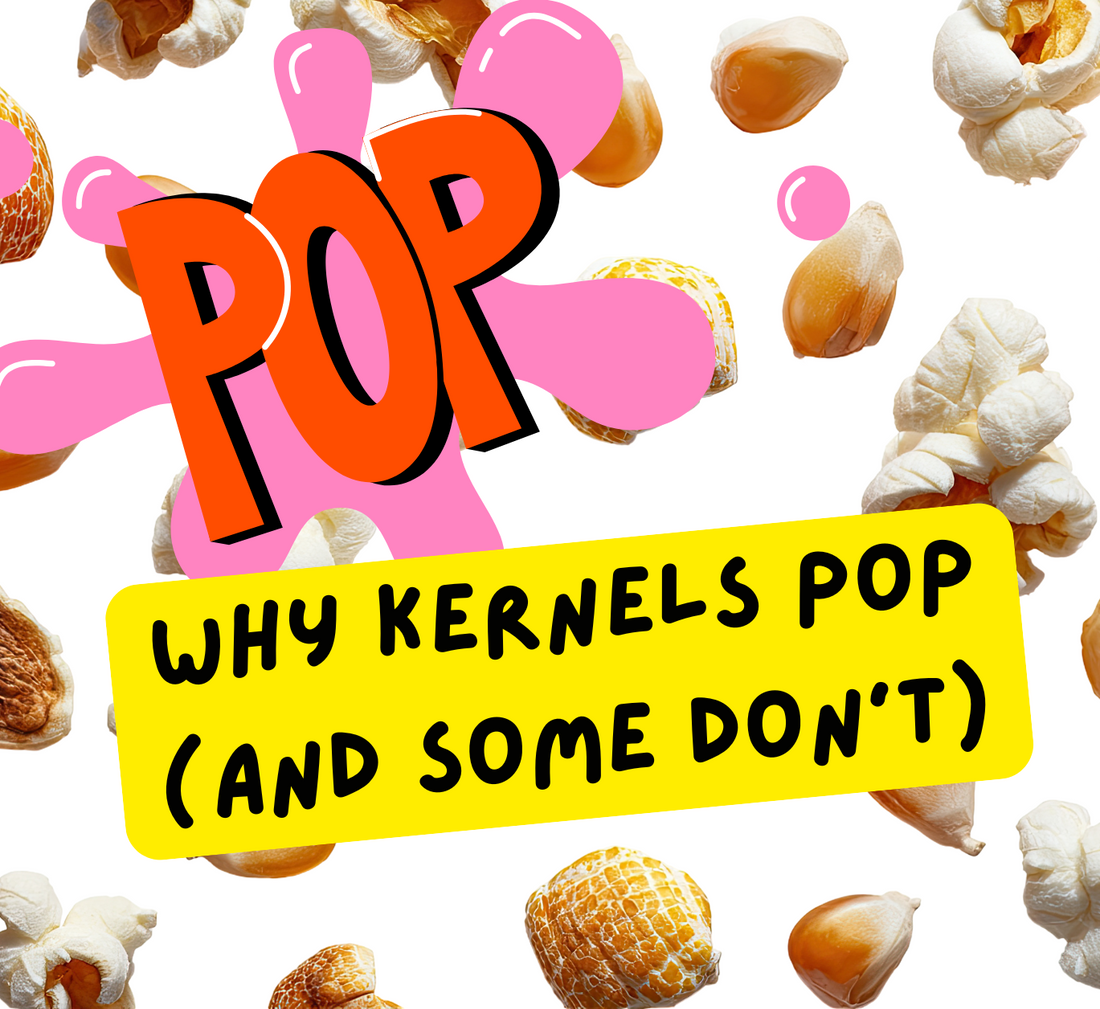
The Science of Pop: How Kernels Pop + Stoveless Hacks
Share
The Science of Pop: What Works, What Doesn’t, and Creative Ways to Pop Without a Stove
When PopCornaa was born back in 2022, the idea wasn’t just to make popcorn taste bold and exciting — it was to really understand the science behind the pop.
I’ve always been addicted to figuring out how anything works. My technical mind craves solution-finding — whether it was during my days back at uni, studying how architecture is built and how structures hold, or pulling apart an electrical component just to see how the circuit runs. That same mindset followed me into food.
I felt reinvigorated, almost like my GCSE science days, when I was determined to win the contest of building the strongest bridge out of straws — and yep, I took the W. That same determination now fuels my popcorn obsession. It’s not just “let’s make popcorn.” It’s “let’s break down the science until we find the method that works best for us.”
This hunger for answers has shaped everything PopCornaa does today — from the way we pop our kernels to how we coat them in bold flavours like Sriracha Soul, Seaweed, Wasabi & Soy, and Coco Green Matcha.
The Science of Popcorn
Popcorn isn’t like any other grain. It’s a natural little science experiment built into a kernel.
Each kernel has three parts that make the magic happen:
-
Pericarp (outer shell): Hard, sealed, and built to trap pressure.
-
Endosperm (starchy core): The fluffy stuff that expands when released.
-
Moisture (about 13–14%): Enough water inside to generate steam.
As the kernel heats up, that moisture turns to steam. Pressure builds inside the shell until — pop! — the kernel explodes and flips itself inside out.
The exact moment happens at around 180°C (356°F). It’s science and snack-time colliding.
Why Only Popcorn Pops
Other grains just don’t have the right build:
-
Rice → cracks but doesn’t expand.
-
Wheat → burns before popping.
-
Sorghum → does a tiny pop, but nowhere near popcorn-level.
Popcorn is basically engineered by nature to pop — the hard shell plus the perfect moisture balance makes it unique.
What Works for Perfect Popping
Since 2022, our experiments (fueled by that “GCSE science bridge champ” energy) have led to a few clear rules. These are the game-changers:
1. Consistent Medium-High Heat
Popcorn needs even heating. Low heat? The kernels sit stubborn. Too high? Burnt shells before they expand.
2. A Touch of Oil
Oil helps with even heating and flavour. But balance matters — too much makes it soggy.
3. Keep It Moving
Whether shaking a pan or stirring in a machine, movement prevents burning and creates consistency.
4. Freshness Is Key
Old kernels lose water, and without enough steam, they just won’t pop. Fresh corn = fluffy corn.
5. Preheat First
Preheated pans or machines give kernels the quick blast they need. Starting cold leads to uneven results.
What Doesn’t Work
Not everything we tried was a win. Here are the fails worth skipping:
-
Microwaving plain kernels in a bowl → lots of burnt patches.
-
Adding water to “steam-pop” → they boiled, not popped.
-
Ultra-low heat popping → left us with scorched husks.
-
Overcrowding pots → trapped steam = chewy, rubbery popcorn.
Sometimes popcorn really tells you when it’s not vibing.
Creative Ways to Pop Corn Without a Stove
Popcorn doesn’t need a stovetop. Here are stoveless hacks we’ve seen (and yes, sometimes laughed at):
Microwave in a Paper Bag
¼ cup kernels + brown paper bag, folded tight, microwaved for 2–3 minutes.
-
Pros: Cheap, easy.
-
Cons: Bags can scorch.
Hot-Air Popper
Blasts hot air to pop without oil.
-
Pros: Clean, fluffy.
-
Cons: A little dry unless you add flavour after.
Campfire Foil Packets
Heavy-duty foil, kernels, oil, sealed and shaken over embers.
-
Pros: Great for camping vibes.
-
Cons: Easy to burn.
Heat Gun or Hairdryer
Blasting kernels in a metal bowl.
-
Pros: Full-on mad scientist vibes.
-
Cons: Low-key the least efficient way possible.
Rice Cooker or Instant Pot
Sauté mode + oil = decent results.
-
Pros: Multi-purpose gadgets.
-
Cons: Not quick.
Sandwich Maker / Waffle Iron
Foil packet inside the press.
-
Pros: Party trick.
-
Cons: Tiny portions.
Solar Popcorn
DIY solar oven with foil and a pizza box.
-
Pros: Eco-friendly, fun for teens.
-
Cons: Takes forever.
Popcorn’s Long History
Popcorn isn’t new at all:
-
Found in caves from 5,000 years ago.
-
Native Americans popped it with hot sand and fires.
-
It became a fairground and circus hit in the 1800s.
-
During the Great Depression, it was one of the cheapest snacks around.
It’s always been a little luxury that survives through time.
Experiments You Can Try
If you love popcorn and science, these are fun at-home tests:
-
Fresh vs Old Kernels → the glow-up difference is wild.
-
Oil vs Air-Popped → compare textures.
-
Different Oils → coconut vs olive vs avocado.
-
Steam Visibility → use a glass lid and watch.
-
Seasoning Stick Test → try dry vs oil-coated.
Why the Science Matters at PopCornaa
Perfect popping isn’t a gimmick — it’s the foundation of our flavours.
When developing Sriracha Soul, for example, we had to make sure every kernel carried the right balance of spice and crunch. Uneven pops meant uneven flavour, and that wasn’t an option.
Dialling in the right heat, oil, and freshness wasn’t just a kitchen hack — it was the backbone of how we scaled PopCornaa from small-batch tests to thousands of bags a day.
Popcorn as a Creative Canvas
Popcorn is one of the most versatile foods out there:
-
Savory: wasabi, herbs, chili dust.
-
Sweet: chocolate drizzle, matcha sugar.
-
Mix-ins: trail mix, cereal bars.
-
Toppings: soups, salads, even desserts.
For us, it’s become the ultimate foodie playground. Whether it’s the fiery kick of Sriracha Soul, the umami hit of Seaweed, Wasabi & Soy, or the grounded flavour of Coco Green Matcha, every new flavour starts with the same question: what if?
Wrapping Up
Popcorn is simple — but never boring. It’s a snack that’s both science and creativity, history and innovation.
Since 2022, our mission has been to push popcorn further by understanding it better. With that same GCSE bridge-building determination, trial and error, and a whole lot of curiosity, PopCornaa has built its flavours on the foundation of popping science done right.
Popcorn will always be more than a snack for us — it’s proof that curiosity, creativity, and a little heat can turn a basic into a full-on glow-up.
FAQs About the Science of Popcorn
Why does popcorn pop?
Popcorn pops because each kernel has a hard shell (pericarp) that traps moisture. When heated to about 180°C, the water turns to steam, pressure builds, and the shell bursts — flipping the starchy centre into fluffy popcorn.
Why don’t all kernels pop?
Unpopped kernels, sometimes called “old maids,” usually lack enough internal moisture. If the kernel is too dry or the heat is uneven, it won’t build the pressure needed to burst.
Can you make popcorn without a stove?
Yes! Creative stoveless hacks include microwaving kernels in a paper bag, using a hot-air popper, cooking over a campfire in foil, or even trying a rice cooker on sauté mode.
Is air-popped popcorn healthier?
Air-popped popcorn uses no oil, so it’s lower in calories and fat. However, oil-popped corn helps seasonings stick better and often has a richer flavour.
What’s the best oil for popping popcorn?
Coconut oil, avocado oil, and canola oil all work well. Coconut oil gives a rich, classic cinema-style taste, while avocado oil has a high smoke point and a clean flavour.
Can I re-pop unpopped kernels?
Sometimes — but not always. If the kernel failed because it was too dry, it won’t pop on a second attempt. If it simply didn’t get enough heat the first time, you may get a few more pops by reheating.
